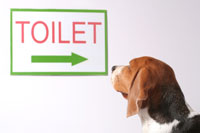Potty Training for Puppies

How To Potty Train Your Puppy
House-training a puppy can be challenging. Whether you’re a first-timer or a seasoned dog owner, knowledge is power. Educating new dog owners on potty training techniques increases success. A 2007 JAVMA article showed that 98.1% of shelter dogs with owners that had been provided five minutes of potty training counseling prior to adoption were successfully house-trained in one month versus 86.4% of the control group that received no additional education.1
Young puppies have little bladder and bowel control at eight weeks of age, but this quickly increases over the next couple of months. With consistency, patience, and time, your puppy will learn what is expected as well as who is in charge. This training will also help prevent other unwanted behavioral problems.
The following techniques are based on positive reinforcement, or praising your puppy for doing a good job. We will address training basics, the role of feeding your puppy in housetraining, the prevention and correction of common problems, and your keys to success.
The cardinal rule when it comes to potty training is to watch your puppy so well that there is no chance of the puppy having an accident. It is critical that you have enough time for training during the first couple of weeks. The goal is for every potty episode to happen outside, where it will be rewarded by you. Anticipating your future together with your puppy grown up and well-trained will make your attention and dedication worthwhile.
Though the steps may seem daunting, don’t stress. Accidents will happen but hopefully these tips will make them few and far between.
- Choose a potty area and be consistent. The potty zone should be in the same area each time you take your puppy out, even in the middle of the night. Use the same exit from the house and same route to the potty zone each time, so your puppy gets familiar with the routine.
- Leash training is helpful. Leash-walk your puppy to the potty zone so he will not have the opportunity to dash off. He will also begin to understand that he is in that particular zone to go potty and not to play or explore. If your puppy strongly resists wearing a leash, conduct the leash training later so that he is not distracted from the potty training that must take place right away. Most puppies resist wearing a leash initially but quickly get used to it.
- Choose your command for potty and stick to it (i.e., "go potty"). Use this command each time you expect your puppy to urinate or defecate in the potty zone. At first, give the command DURING (rather than before) the urination or defecation so he understands the meaning of this new command.
- Give a reward for every successful episode in the potty zone. You want your puppy to know he did an awesome job when he potties in the right place. A verbal reward system is preferable because it will always be readily available and won’t conflict with diet changes or preferences later in your puppy’s life. Puppies also consider play a reward.
- Timing is critical. Bladder control is a primary concern when a puppy is first being house-trained. Take your puppy outside to the potty zone every hour until you establish his pattern. Spend several minutes in the potty zone leash-walking your puppy until he goes potty. If no elimination occurs after five minutes, go inside and return to the potty zone ten minutes later. Repeat this pattern until elimination occurs.
- Nonverbal cues such as circling, sniffing, whining, and heading for the door are all clues your puppy may give that he needs to go potty. You will eliminate many accidents by getting to know your puppy’s habits and behaviors. Using a long leash to attach him to you may be a good option to help keep an eye on him while house-training.
- Crate training. When crate training your puppy choose a crate big enough for him to stand, turn around, and lie down in comfortably. Keep in mind the eventual full-grown size of your puppy, but remember that if you purchase a huge crate for a tiny puppy the likelihood of him having accidents at the far end of the crate is higher. Some crates offer a barrier in order to reduce the interior size of the crate until your puppy grows and more space is needed. Use the crate when you can’t watch your puppy, as well as at night, until he is considered trained. This will also help deter other unwanted negative behaviors such as chewing, scratching and barking. Place the crate in an area of your home where your puppy will associate it with eating or sleeping. The kitchen, especially near the exit door to the potty zone, is a good option. Your bedroom may also be a good option to give extra security to your puppy at night. Note: Puppies under six months of age should not remain in a crate for more than three to four hours at a time, and that’s still pushing it. For more info on crate training visit The Humane Society.
- Record any accidents that occur in order to evaluate the pattern so you can correct problems in particular areas. Write down the time of day, the place it occurred, and what you and your puppy were doing at the time. Clean the soiled area well and deodorize it to prevent future marking of the same area. Choose cleaning products without ammonia, since it smells like urine and may attract your puppy to soil that same area again.
- Don’t use punishment. Positive reinforcement of all the eliminations that occur outside in the potty zone will create better results than anger and punishment. If you strike, yell at, or otherwise threaten your puppy, he may begin to fear you and hide from you rather than indicate that he needs to go out to the potty zone. Puppies do not understand why you are so upset unless you catch them during an accident. Even if you do catch him pottying in the house, use that opportunity to redirect rather than punish him. Pick him up and take him to the potty zone immediately and praise him for finishing outside. In this way, you can still give positive reinforcement. If you don’t catch your puppy having the accident, simply clean it up well and move on.
- Feeding your puppy while training (first 2-4 weeks). During the first two to four weeks of training, the puppy’s meals need to be the same amount given at the same time each day based on your veterinarian’s recommendation. Leave the food down for 15 minutes, then pick up what is left and take your puppy out to the potty zone. Water should be unrestricted, but watch for your puppy drinking because he will need to go potty right away. Pick the water up about an hour before bedtime so he doesn’t have to potty just after being locked into the crate for bedtime.
- Paper training is not recommended. Dogs cannot distinguish between which papers and surfaces are appropriate for going potty and which are not. The likelihood of your puppy eliminating where you don’t want him to is very high. Also, consistently training the puppy to eliminate only in the potty zone leads to earlier success.
- There are some cases where people cannot be home to let their puppy outside at the appropriate times and so they feel they should provide an area for their puppy to eliminate indoors. This is understandable, but it will complicate the training and the end result will likely not be the same. Instead, plan for house-training ahead of time and enlist help (possibly a pet sitter) to take your puppy to the potty zone.
- There is considerable variation between dog breeds as well as individual puppies in how easy they will be to potty train. In all cases consistency and patience are key.
- Success. If it has been one month with no accidents in the house you can gradually decrease supervision of your puppy. The first time he has unsupervised free time should be immediately after a successful outdoor potty to boost his confidence.
Take him to the potty zone immediately after he naps, plays, chews, eats, or drinks. You may need to carry especially young pups out from their crate after naps due to their limited bladder control. This is especially true if the distance to your potty zone is far, or if your puppy becomes very excited to see you.
Before bed, take him out to the potty zone, and again six to eight hours later.Congratulations and good luck! Enjoy your precious new puppy.
Resource:
- Herron, Meghan E., et al. Effects of preadoption counseling for owners on house-training success among dogs acquired from shelters. Journal of the American Veterinary Medical Association. [Online] August 15, 2007. avmajournals.avma.org/doi/abs/10.2460/javma.231.4.558?cookieSet=1&journalCode=javma.%20DOI%2010.2460/ javma.231.4.558.
You May Also Like These Articles:
Causes of Frequent Urination and Urinary Accidents in Dogs
How to Stop Your Dog from Jumping on People
How to Stop a Dog from Digging
Disclaimer: This website is not intended to replace professional consultation, diagnosis, or treatment by a licensed veterinarian. If you require any veterinary related advice, contact your veterinarian promptly. Information at DogHealth.com is exclusively of a general reference nature. Do not disregard veterinary advice or delay treatment as a result of accessing information at this site. Just Answer is an external service not affiliated with DogHealth.com.
Notice: Ask-a-Vet is an affiliated service for those who wish to speak with a veterinary professional about their pet's specific condition. Initially, a bot will ask questions to determine the general nature of your concern. Then, you will be transferred to a human. There is a charge for the service if you choose to connect to a veterinarian. Ask-a-Vet is not manned by the staff or owners of DogHealth.com, and the advice given should not delay or replace a visit to your veterinarian.



